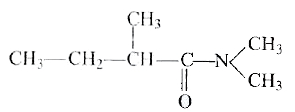Consider the following sequence of reactions :
H2C=CH−CH=CH2Br2(1 mole)−−−−−−−−−→CCI4A1.KCN (excess)−−−−−−−−−−−→2.H2,NiB
The end product (B) is :
H2N−(CH2)2−CH=CH−(CH2)2−NH2
H2N−(CH2)6−NH2
NC−CH2−CH=CH−CH2−CN
H2C=CH−C∣NH2H−(CH2)2−NH2
The correct Answer is:B
To solve the given sequence of reactions, we will break down each step and identify the products formed at each stage.
Step 1: Identify the starting compound
The starting compound is a diene, which can be represented as:
H2C=CH−CH=CH2
Step 2: Reaction with Bromine
The diene reacts with bromine (Br₂) in the presence of carbon tetrachloride (CCl₄). This reaction leads to the addition of bromine across the double bonds. The product formed (let's call it A) will have bromine atoms added to the carbon atoms where the double bonds were present.
The reaction can be represented as:
H2C=CH−CH=CH2+Br2→A
The product A will be:
Br−CH2−CH−CH−Br
Step 3: Reaction with KCN
Next, the product A undergoes a reaction with excess potassium cyanide (KCN). In this step, the bromine atoms are replaced by cyanide (CN) groups through a nucleophilic substitution reaction.
The reaction can be represented as:
A+2KCN→B+2KBr
The product B will now have cyanide groups attached to the carbon atoms where the bromine atoms were present:
CN−CH2−CH−CH−CN
Step 4: Hydrogenation
The final step involves the hydrogenation of product B using hydrogen gas (H₂) in the presence of a nickel catalyst (Ni). This reaction will convert the cyanide groups into amine groups (NH₂) and will also saturate the carbon chain.
The reaction can be represented as:
B+2H2→C4H8N2
The final product B will be:
NH2−CH2−CH−CH−NH2
Final Product
Thus, the end product B is:
NH2CH2CH(NH2)CH2
Summary of the Steps
1. Start with the diene: H2C=CH−CH=CH2.
2. Add Br₂ in CCl₄ to form product A: Br−CH2−CH−CH−Br.
3. React with KCN to form product B: CN−CH2−CH−CH−CN.
4. Hydrogenate to form the final product: NH2−CH2−CH−CH−NH2.
The starting compound is a diene, which can be represented as:
H2C=CH−CH=CH2
The diene reacts with bromine (Br₂) in the presence of carbon tetrachloride (CCl₄). This reaction leads to the addition of bromine across the double bonds. The product formed (let's call it A) will have bromine atoms added to the carbon atoms where the double bonds were present.
H2C=CH−CH=CH2+Br2→A
Br−CH2−CH−CH−Br
Next, the product A undergoes a reaction with excess potassium cyanide (KCN). In this step, the bromine atoms are replaced by cyanide (CN) groups through a nucleophilic substitution reaction.
A+2KCN→B+2KBr
CN−CH2−CH−CH−CN
The final step involves the hydrogenation of product B using hydrogen gas (H₂) in the presence of a nickel catalyst (Ni). This reaction will convert the cyanide groups into amine groups (NH₂) and will also saturate the carbon chain.
B+2H2→C4H8N2
NH2−CH2−CH−CH−NH2
Thus, the end product B is:
NH2CH2CH(NH2)CH2
1. Start with the diene: H2C=CH−CH=CH2.
2. Add Br₂ in CCl₄ to form product A: Br−CH2−CH−CH−Br.
3. React with KCN to form product B: CN−CH2−CH−CH−CN.
4. Hydrogenate to form the final product: NH2−CH2−CH−CH−NH2.
Similar Questions
Knowledge Check
Consider the following sequence of reactions.
C6H6+CH3CH=CH2H3PO4−−−−−−→heatA1.O2.heat−−−−−−−−−→2.H3O+,heatB+C
The products (B) and (C) are :Abenzaldehyde and acetaldehydeBbenzoic acid and acetic acidCphenol and propionaldehydeDphenol and acetoneH3C−CH2−CH3∣CH−C∣∣O−NH2Br2+KOH−−−−−−−−−→ΔA1.CH3I(excess)−−−−−−−−−−−−→2.AgOH,ΔB
The major product (B) is :ACH3−CH2−CH=CH2B CH3C−CH=CH−CH3D
CH3C−CH=CH−CH3D
Consider the following reaction sequence ,
CH3CH(OH)CH3ConcH2SO4−−−−−−−−→HeatXdil.H2SO4−−−−−−−−→H2OY
X and Y in the reaction respectively areACH3CH=CH2,CH3CH(OH)CH3BCH3CH=CHCH3,CH3CH2CH2OHCCH3CH2CH=CH2,CH3,CH2CH2OHDCH3CH2CH2CH3,CH3CH(OH)CH2CH3
In the following sequence of reaction, the product C is
CH3−BrKCN−−→AH2O+−−−→BLiAlH4−−−→EtherC
View SolutionIn the following reaction sequence
Ph−C≡CHaq.H2SO4−−−−−→Hg2+A1.CH3MgI−−−−−−→2.H2OB
the product (B) is
View SolutionConsider the following sequence of reactions.
_E01_717_Q01.png) HOCH2.CH2OH−−−−−−−−−−→H+A1.LiAIH4,Et2O−−−−−−−−−→2.H3O+B
HOCH2.CH2OH−−−−−−−−−−→H+A1.LiAIH4,Et2O−−−−−−−−−→2.H3O+B
The products (A) and (B) are, respevtively.
View SolutionComplete the following reaction CH3−C∣CH3=CH−CH3H2,Ni−−−→?
View SolutionConsider the following reaction,
H2C=CH−CH2CH2−OHBr2/CCl4−−−−−→ADil. KOH−−−−−→25∘CB
The product B is :
View Solution
